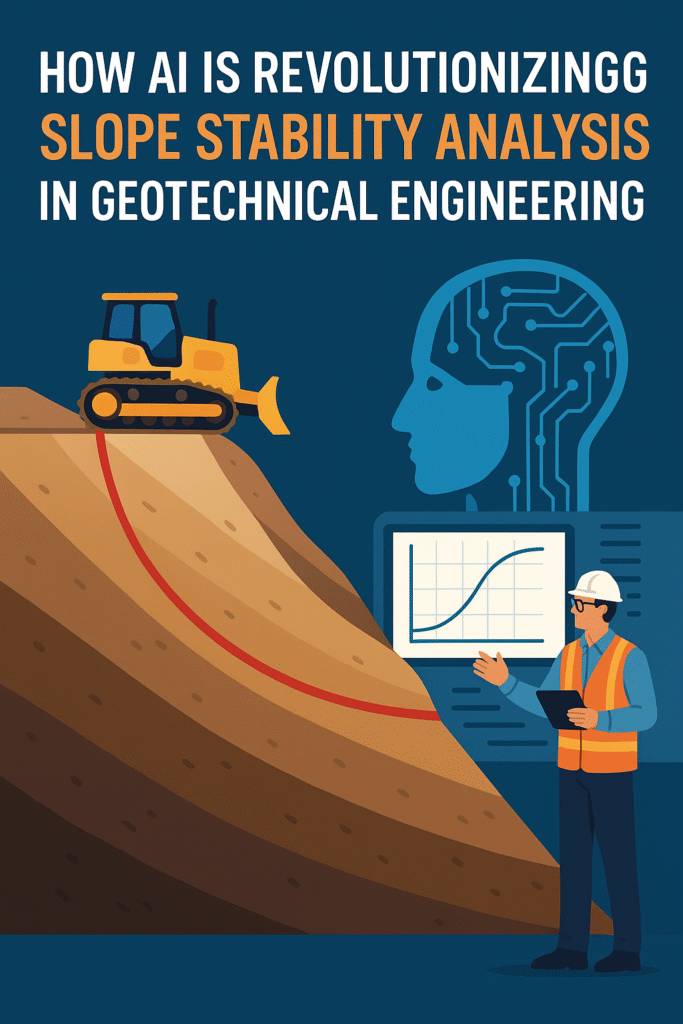
Illustration by Chat GPT
Slope failures and landslides pose significant threats to infrastructure, communities, and lives worldwide. From highway embankments to natural hillsides, understanding and predicting slope behavior has been one of geotechnical engineering’s most challenging problems. Traditional approaches, while foundational, often struggle with the complex, interconnected variables that influence slope stability. Enter artificial intelligence: a game-changing technology that’s transforming how we analyze, monitor, and manage slope stability.
For decades, geotechnical engineers have relied on factor of safety calculations and limit equilibrium methods to assess slope stability. While these approaches provide valuable insights, they often oversimplify the complex reality of slope behavior. AI changes this paradigm by processing vast amounts of data and identifying subtle patterns that human analysis might miss.
Machine learning models can simultaneously analyze dozens of variables—soil strength parameters, groundwater fluctuations, slope geometry, rainfall patterns, and seismic activity—to generate more nuanced stability assessments. Unlike traditional methods that assume linear relationships, AI algorithms excel at detecting non-linear interactions between these factors, providing a more realistic picture of slope behavior.
Perhaps the most exciting application of AI in slope stability is its predictive capability. By analyzing historical failure data alongside current monitoring information, machine learning models can generate probabilistic failure forecasts that go far beyond simple “stable” or “unstable” classifications.
These predictive models are particularly valuable because they can identify warning signs weeks or even months before a potential failure. This extended prediction window provides crucial time for implementing emergency measures, evacuating at-risk areas, or deploying stabilization techniques.
The integration of AI with traditional geotechnical analysis methods is also advancing. Machine learning is being used to calibrate complex soil behavior models and enhance finite element analyses, enabling more accurate assessments of progressive failure mechanisms and time-dependent behavior.
While AI offers tremendous promise for slope stability analysis, it’s important to recognize current limitations. These systems require substantial amounts of quality data for training, and their effectiveness depends heavily on the representativeness of that data. Additionally, the “black box” nature of some AI algorithms can make it challenging to understand exactly how they reach their conclusions, which is a consideration in engineering applications where explainability is important.
For geotechnical engineers, embracing AI doesn’t mean abandoning fundamental engineering principles. Instead, it means augmenting traditional expertise with powerful new tools that can process information at scales and speeds impossible for human analysis alone. The result is a more comprehensive, accurate, and proactive approach to slope stability that benefits everyone who lives, works, or travels in areas where slopes matter.
Suggested articles:
Gao and Ge, 2024, A comprehensive review of slope stability analysis based on artificial intelligence methods, Expert Systems with Applications Volume 239, 1 April.
Xu, He, Shan, Niu and Sheng, 2023, Machine Learning in the Stochastic Analysis of Slope Stability: A State-of-the-Art Review, Modelling 2023, 4(4), 426-453; https://doi.org/10.3390/modelling4040025.
Suman, Khan, Das & Chand, 2016, Slope stability analysis using artificial intelligence techniques, . Nat Hazards 84, 727–748 (2016). https://doi.org/10.1007/s11069-016-2454-2.
Yadav, Chattopadhyay, Tripathy, Mishra & Singh, Enhanced slope stability prediction using ensemble machine learning techniques, Sci Rep 15, 7302 (2025). https://doi.org/10.1038/s41598-025-90539-6.
Zerouali, Bailek, Tariq, Kuriqi, Guermoui, Alharbi, Khafaga & El-kenawy, 2024, Enhancing deep learning-based slope stability classification using a novel metaheuristic optimization algorithm for feature selection, Sci Rep 14, 21812 (2024). https://doi.org/10.1038/s41598-024-72588-5.

